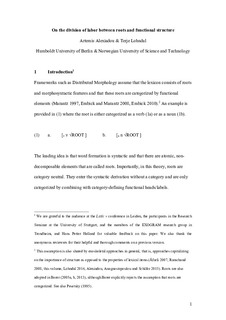| dc.contributor.author | Alexiadou, Artemis | |
| dc.contributor.author | Lohndal, Terje | |
| dc.date.accessioned | 2018-02-14T13:41:26Z | |
| dc.date.available | 2018-02-14T13:41:26Z | |
| dc.date.created | 2017-04-27T17:58:41Z | |
| dc.date.issued | 2017 | |
| dc.identifier.isbn | 9780198767893 | |
| dc.identifier.uri | http://hdl.handle.net/11250/2484749 | |
| dc.description.abstract | This chapter argues that there is a typology of languages according to how much meaning a root encodes independently of its syntactic categorization. This typology is illustrated by an in-depth discussion of three languages: English, Greek, and Hebrew. Hebrew is argued to represent one end of the scale where the root encodes a minimal and highly abstract meaning. English represents the other end where the root has a severely restricted meaning. The two languages differ in terms of the role of functional morphology, which is crucial in Hebrew but not at all a central part of English. Greek is important in the sense that the language falls in between English and Hebrew: it has some highly general and abstract roots, and it has some roots with highly determined and specified meanings. | nb_NO |
| dc.language.iso | eng | nb_NO |
| dc.publisher | Oxford University Press | nb_NO |
| dc.relation.ispartof | The Verbal Domain | |
| dc.title | On the division of labor between roots and functional structure | nb_NO |
| dc.type | Chapter | nb_NO |
| dc.description.version | acceptedVersion | nb_NO |
| dc.source.pagenumber | 85-102 | nb_NO |
| dc.identifier.doi | 10.1093/oso/9780198767886.003.0004 | |
| dc.identifier.cristin | 1467059 | |
| dc.description.localcode | This is a draft of a chapter/article that has been accepted for publication by Oxford University Press in the book The Verbal Domain. | nb_NO |
| cristin.unitcode | 194,62,60,0 | |
| cristin.unitname | Institutt for språk og litteratur | |
| cristin.ispublished | true | |
| cristin.fulltext | postprint | |
| cristin.qualitycode | 2 | |
